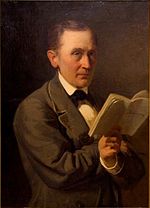Estonian literature
The cultural stratum of Estonian was originally characterised by a largely lyrical form of folk poetry based on syllabic quantity.
At a professional level, traditional folk song reached its new heyday during the last quarter of the 20th century, primarily thanks to the work of composer Veljo Tormis.
In modern times A. H. Tammsaare (1878–1940), Jaan Kross (1920–2007), Andrus Kivirähk (born 1970), and Robert Kurvitz (1984) remain Estonia's best known and most translated writers.
As opposed to the recent nature of written literature, the oral tradition, found in collections of Estonian folklore, tells of the ancient pre–Northern Crusades period of independence.
The earliest example of Estonian language poetry dates back to 1637, a poem written by Reiner Brockmann (1609–1647), teacher of Greek at the Tallinn Gymnasium.
One of Peterson's projects was fulfilled in his lifetime, the German version of Kristfrid Ganander's Mythologia Fennica, a dictionary of Finnish mythological words and names (the Swedish original was published in 1789).
Peterson's translation of Ganander's dictionary found many readers in Estonia and abroad, becoming an important source of national ideology and inspiration for early Estonian literature.
The Estonian Writers Union was founded in 1922; the literary monthly Looming (Creation) first appeared in 1923 and is still the main periodical of its sort in Estonia.
His five volume epic novel Tõde ja Õigus (Truth and Justice, 1926–1933) is considered one of the major works of Estonian literature.
A number of prominent writers who spent the war years in Estonia fled from Soviet forces to Germany in 1944 (Visnapuu) or to Sweden, either directly or via Finland (Suits, Under, Gailit, Kangro, Mälk, Ristikivi).
Many of those who remained behind and did not follow the ideology of the Soviet occupying power suffered either death in Siberia (Talvik and playwright Hugo Raudsepp) or a combination of repression, a ban on publication and interior exile (Tuglas, Alver, Masing).
Despite the modest circumstances of the war and post-war years, creative activity and publishing started almost immediately, both in the temporary stopovers in Finland, and in the refugee camps in Sweden and Germany.
Eesti Kirjanike Kooperatiiv, the largest Estonian-language publishing house in exile, was set up and its method of book distribution secured the continuity of literary life on an institutional level and on a global scale, except in the Soviet-controlled homeland.
The poetry collection by surrealist Ilmar Laaban (1921–2000) was at first the only modernist work, until 1953 when Karl Ristikivi, essentially a conservative writer, published his novel The Night of the Souls.
The subject matter of literary output was greatly enriched by descriptions of the countries where various writers had settled, like Karl Rumor (1886–1971) in Brazil, or Gert Helbemäe (1913–1974) in England.
In Estonia a relaxation of the strictures of the Soviet regime after the death of Stalin opened the way for various Estonian writers: Minni Nurme (1917–1994), Jaan Kross (1920–2007) Artur Alliksaar (1923–1966), Ain Kaalep (1921–2020), Kersti Merilaas (1916–1986) and Ellen Niit (1928–2016).
The political stagnation that followed the crushing of the Prague Spring in 1968 was reflected in Paul-Eerik Rummo's initially banned minimalist collection.
On his return from the labour camps and internal exile in Russia, where he spent nine long years (1946–1954) as a political prisoner, Kross breathed new life into Estonian poetry.
[16] Jaan Kaplinski was the most productive Modernist in Estonian poetry; he wrote essays and plays, translated, lectured home and overseas and was Writer-in-Residence at the University of Wales, Aberystwyth.
Jürgen Rooste (1979), Ivar Sild (1977), Wimberg (pen name of Jaak Urmet, 1979) and Kristiina Ehin (1977) have all distinctive voices combined with a profound knowledge of both Estonian and world literature.
[18] Sild proclaims his gay outlook, Wimberg creates absurd landscapes through the use of childlike language and style[19] and Ehin maintains the tradition of the "great female poet" of Estonia.




